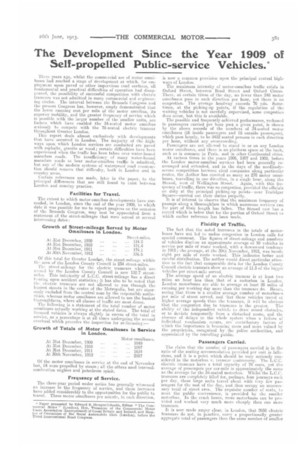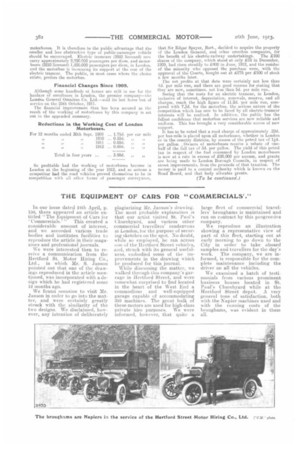The Development Since the Year 1909 of Self-propelled Public-service Vehicles.*
Page 5

Page 6

If you've noticed an error in this article please click here to report it so we can fix it.
Three years ago, whilst the commercial use of motor omnibuses had reached a stage of development at which, for employment upon paved or other impervious road surfaces, all fundamental and practical difficulties of operation had disappeared, the possibility of successful competition with electric tramcars was not admitted in many commercial and engineering circles. The interval between the Brussels Congress and the present Congress has, however, amply demonstrated that the lower running cost per mile of the motor omnibus, its superior inability, and the greater frequency of service which is possible with the larger number of the smaller units, are factors which have enabled the 34-seated motor omnibus ecriously to compete with the 78-seated electric tramcar throughout Greater London.
Tins report deals almost exclusively with developments that have occurred in London. The majority of the highways upon which London services are conducted are paved with asphalte, granite or wood; certain difficulties have been experienced when the traffic has been taken over water-booed macadam roads. The insufficiency of many water-bound macadam roads to hear motor-omnibus traffic is admitted, but any of the modern systems of waterproof road construction should remove that difficulty, both in London and in country areas.
Certain references are made, later in the paper, to the principal differences that are still found to exist between London and country practice.
Facilities for Travel.
The extent to which motor-omnibus developments have succeeded, in London, since the end of the year 1909, to which date it was possible for me to report progress on the occasion of the Brussels Congress, may best be appreciated from a statement of the street-mileages that were served at several intervening dates:
Growth of Street-mileage Served by Motor Omnibuses in London.
trve temil es.
At 31st December, 1909 ... ... 114.8 At 31st December, 1910 ... ... 121.4 At 31st December, 1911 ... ... 174.1 At 30th November, 1912 ... .. 336.6 Of this total for Greater London, the street-mileage within the areaof the. London County Council is 234 street-miles. The street-mileage for the electric tramcars which are owned by the London County Council is now 132.7 streetmiles. This inferiority of L.C.C. street-mileage has a direct haring upon accident statistics; it has also to he noted that the electric tramcars are not allowed to run through the busiest streets in the centre of the Metropolis, but are rigorously excluded from the central zone by the responsible authorities, whereas motor omnibuses are allowed to use the busiest thoroughfares, where all classes of traffic are most dense. The following is a statement of the total number of motor omnibuses actually working at the stated dates. The total of licensed vehicles is always slightly in excess of the total in service, as a percentage is at all times undergoing the annual overhaul which precedes the inspection for re-licensing :— Growth of Totals of Motor Omnibuses in Service in London, Motor omnibuses.
At 31st December, 1909 ... 1049 At 31st December, 1910 ... 1097 At 31st December, 1911 ... 1634 At 30th November, 1912 ... 2527
Of the motor omnibuses in service atthe end of November last, 84 were propelled by steam ; all the others used internalcombustion engines and petroleum spirit.
Frequency of Service.
The three-year period under notice has generally witnessed an increase in the frequency of service, and these increases have added considerably to the opportunities for the public to travel. Three motor omnibuses per mieute, in each direction,
. Paper presented by Edward S. Shrapnell-Smith, Editor "The Commercial Motor" (London), lion. Treasurer of the Commercial Motor Users Association (Incorporated) of Great Britain and Ireland, and Member of Committee of the Royal, Automobile Club (London), before the 7'iiird International Road Congress.
is now a common provision upon the principal central highways of London.
The maximum intensity of motor-omnibus traffic exists iLL Oxford Street, between Bond Street and Oxford Circus.
There, at certain times of the day, no fewer than 248 motor omnibuses pass in each direction per hour, yet there is no congestion. The average headway exceeds 70 yds. Sometimes, at the picking-up points, if the regulation of the waiting vehicles is not carefully supervised, some congestion does occur, but this is avoidable. The possible and frequently-achieved performance, reckoned in passengers carried per hour past a given point, is shown by the above records of the numbers of 34-seated motoromnibuses (16 inside passengers and 18 outside passengers), which pass hourly, to be 8432 seated persons in each direction per hour, without any overcrowding. Passengers are not allewed to stand in or on any London motor omnibuses, and there is no platform space at the hack, such as is common in Paris. and in other Continental cities.
At various times in the years 1906, 1907 and 1908, before the London motor-omnibus services had been generally re arranged and estended, and in the clays of the needlessly
severe competition between rival companies along particular routes, the Author has counted as ninny as 270 motor omni
buses, travelling in one direction, in a single hour, along the
Strand, west of Wellington Street. Again, with this frequency of traffic, titers was no congestion, provided the officials on duty at the principal picking-up points—near Trafalgar Square—carried out their duties properly.
It is of interest to observe that the Maximum frequency of passage along a thoroughfare in which numerous services run
for part of their length has fall-en. The Strand now has a record which is below that for the portion of Oxford Street to which earlier reference has been made.
Fluidity of Traffic.
The fact that the noted increases in the totals of motorbuses have not led to undue congestion in London calls for special comment. The figures of street-mileage and numbers of vehicles disclose an approximate average of 10 vehicles in service per mile of route worked, with a downward tendency in 1912; the average, at the 30th November, 1912, was barely eight per mile of route worked. This indicates better and careful distribution. The author would direct particular atten. tion to the fact that cenaparable data for the London County Council electric tramcars show an average of 11.5 of the bigger vehicles per street-mile served.
The average speed of an electric tramcar is at least two miles an hour less than that of a motorbus in Louden. London motorbuses are able to average at least 20 miles of running per working day more than the tramcars do. Hence, seeing that, there is a smaller average number of motorbuses per mile of street served, and 'bat these vehicles travel at higher average speeds than the tramcars, it will be obvious that the congestion due: to tramcars is the greater. The ability of the independent valeta to draw round obstacles, or to deviate temporarily from a disturbed route, and the absence of delays to the whole system when a failure of individual mechanism occurs, are contributory factors of which the importance is becoming more and more valued by the proprietors, recognized by the police authorities, and appreeiated by the travelling public.
Passengers Carried.
The claim that the number of passengers carried is in the ratio of the seating accommodation provided per unit is fallacious, and it is a point which should be very seriously considered in the motorbus v. tramcar controversy. The L.C.C. electric tramcars have a total capacity of 78 seats, yet the average of passengers per ear-mile is approximately the AaMe as the average for the 34-seated motorbus. Whilst the L.C.C. tramcars are completely filled for, perhaps, four journeys each per day, these large units travel about with very few passengers for the rest of the day, and thus occupy an unnecessary total of street area. The requisite number of seats, to meet the public convenience, is provided by the smaller motorbus. In the crush hours, more motorbuses can be provided and worked very much more cheaply than can more tramcars.
It is now made amply clear, in London, that 2650 electric tramcars do not, in peactice, carry a proportionally greater aggregate total of passengers than the same number of smaller motorbuses. It is therefore to the public advantage that the smaller and less obstructive type of public-passenger vehicle should be encouraged. Electric tramcars (2882 licensed) now carry approximately 2,250,000 passengers per diem, and motorbuses (2810 licensed) 1,850,000 passengers per diem, in London, and the motorbus is increasing its support at the cost of the electric tramcar. The public, in most cases where the choice exists, prefers the motorbus.
Financial Changes Since 1909.
Altheugh some hundreds of horses are still in use fur the haulage of omnibuses in London, the premier company—the London General Omnibus Co. Ltd.—sold its last horse 'out of service on the 25th October, 1911.
The financial improvement that has been secured as the result of the working of motorbuses by this company is set out in the appended summary.
So profitable had the working of motorbuses become in London at the beginning of the year 1912, and so serious a competitor had the road vehicles proved themselves to be in competition with all other forms of passenger conveyance, that Sir Edgar Speyer, Bart., decided to acquire the property of the London General, and other omnibus companies, for the benefit of his electric-railway undertakings. The £1.00 shares of the company, which stood at only £18 in December, 1909, had risen steadily to 400 in June, 1912, and the residue of the minority who opposed the purchase were, with the approval of the Courts, bought out at £275 per £100 of stock a few months later.
The net profits at that date were certainly not less than 4d. per mile run, and there are good reasons for stating that they are now, sometimes, not less than 5d. per mile run.. Seeing that the costs for an electric tramcar, in London, inclusive of interest, depreciation, renewals, reserve, and all charges, reach the high figure of 11.2d. per mile run, compared with 7.3d for the motorbus, the serious nature of tho competition which has now to he faced by all electric-tramcar interests will be realized. In addition, the public has the fullest confidence that motorbus services are now reliable and uniform. This has brought a very considerable access of new support. It has to be noted that a road charge of approximately .22d. per bus-mile is placed upon all motorbuses, whether in London or in the country districts, by reason of the petrol tax of 10. per gallon. _Owners of motorbuses receive a rebate of onohalf of the full tax of 3d. per gallon. The yield of this petrol tax in respect of the fuel consumed by London motorbuses is now at a rate in excess of £80,000 per annum, and grants are being made to London Borough Councils, in respect of street improvements, from the proceeds of that taxation. The money is paid to a central authority which is known vs the Road Board, and that body allocates grants.
































